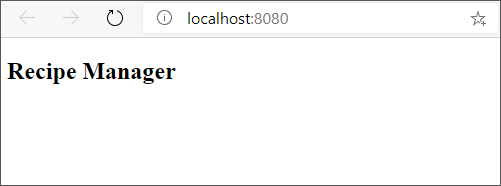Create your first component
React development is based on components. These self-contained units are designed for reuse and modularity. React projects typically contain many components.
A component can be either a function or a class. Most React developers prefer to create components by using functions, so we'll focus on this style.
Applications generally have one core component, commonly called an App. The App acts as the root of the application. We'll start by creating our App component.
Create the component
Open Visual Studio Code.
Create a new file in src. Name it App.jsx.
Add the following code:
import React from 'react'; function App() { return ( <article> <h1>Recipe Manager</h1> </article> ) } export default App;
Explore the code
We start the App.jsx file by importing React so we can use JSX syntax. We then create a function named App, like we would create any other function in JavaScript. Finally, we export the function by using the standard JavaScript syntax. The core of our component is contained in the return statement.
Notice that we're using HTML (technically XML) embedded in JavaScript. This functionality shows the power of JSX. We can use the logic and power of JavaScript to create self-contained units of work (components).
The HTML returned by the function (or component) is displayed on the page. The heading contains the text Recipe Manager.
Note
The h1 element nests inside an HTML 5 article element. Because JSX uses XML, we must have one root element. The article element is the root for this component. This structure allows us to add HTML and other React components as our application grows.
Update the application to use the core component
Let's update our application to use our new component.
Open index.jsx.
After the line that reads
import ReactDOM from 'react-dom';(it should be line 3), add the following code:import App from './App';Find the code that reads
<h1>Hello, world!</h1>. Replace this initial message with a call to theAppcomponent:<App />
Explore the code
Here are the complete contents of index.jsx now:
import React from 'react';
import ReactDOM from 'react-dom';
import App from './App';
ReactDOM.render(
<App />,
document.getElementById('app')
);
Our import statement imports our component by using the same syntax we would use for any other module. We can now use the component as if it were HTML.
Note
Because JSX uses XML syntax, we must close the App tag. We can do this by using either the long-form syntax <App></App> or the "self-closing" shorthand <App />. Both options work the same, but most developers use the shorthand option.
See the results
Save all of the files. The browser automatically refreshes with the results!
